In a ‘transformational’ discovery, scientists have discovered the strongest evidence of life on a distant alien planet.
Using data from the James Webb Space Telescope, astronomers found huge quantities of chemicals produced by life on Earth in the atmosphere of the planet K2-18b.
According to scientists from the University of Cambridge, an ‘ocean that is teeming with life’ is the best explanation for this stunning discovery.
But what would that alien life look like?
MailOnline has used AI to take scientists’ best predictions and imagine what life might be like on K2-18b.
The most likely scenario is that K2-18b’s oceans are filled with something like phytoplankton – microscopic organisms that feed on the energy from the nearby star.
However, where there are plankton there is also the possibility of more complex lifeforms evolving to feed on this abundant food supply.
That could mean K2-18b is teaming with strange lifeforms, from filter-feeding shrimp to alien flying fish.
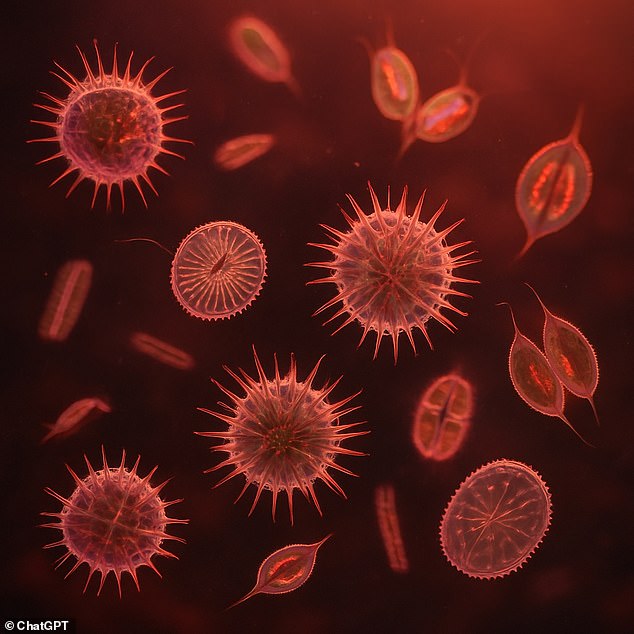
Scientists say life on the planet K2-18b will likely be microscopic phytoplankton (AI Impression)
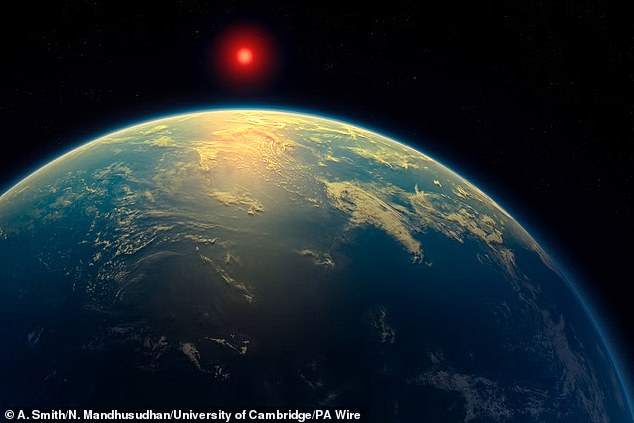
Researchers found traces of chemicals produced by life in the atmosphere of K2-18b (artist’s impression), a planet 124 light-years from Earth. This planet is most likely a ‘Hycean’ world covered by oceans
Plankton
K2-18b is an exoplanet located around 124 light-years from Earth in the constellation of Leo.
It is 2.6 times larger and 8.6 times as massive than Earth, and experts believe it is likely covered in an ocean – making it what they call a ‘Hycean world’.
From observations, scientists know that K2-18b is orbiting a red dwarf star in an area known as the ‘habitable zone’ in which liquid water can exist.
As the planet passes in front of its star, scientists can record how different chemicals in the atmosphere absorb the light.
This revealed the chemical fingerprints of dimethyl sulfide (DMS) and dimethyl disulfide (DMDS), which are only made on Earth by living creatures.
Dr Arik Kershenbaum, a zoologist from the University of Cambridge says: ‘It’s a complex chemical that decays really quickly. So, if you see it there, then something must be making it.’
Although scientists can’t be 100 per cent certain that K2-18b is a Hycean world, if it is, then the oceans would be the most likely place for life to develop.
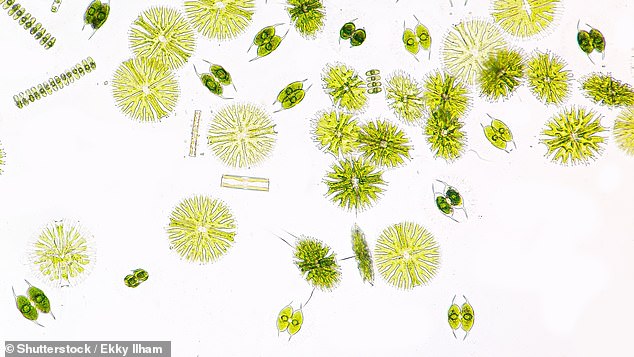
On Earth, DMS and DMDS are only produced by living organisms – mostly microbial life such as marine phytoplankton (like the ones pictured)
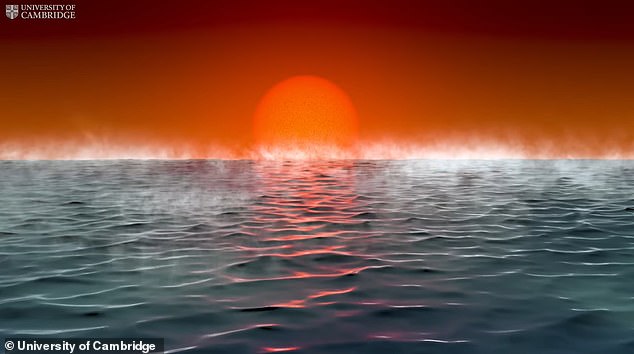
K2-18b is thought to be a ‘Hycean’ world (depicted) – a class of exoplanet possessing key ingredients for alien species because of their hydrogen-rich atmospheres and oceans of water. Life most likely exists near the surface of the water, feeding on the energy from the star
However, Dr Arik Kershenbaum, a zoologist from the University of Cambridge and author of The Zoologists Guide to the Galaxy, says that life on K2-18b would be quite different to life on Earth today.
‘Even if there is an ocean on this planet it’s going to look more like what Earth looked like three or four billion years ago when life first evolved,’ he said.
‘So, one thing we can say pretty confidently is that the vast majority of planets that have any sort of life on them are going to have simple life on them.’
That means the most likely form of life will be microscopic organisms such as phytoplankton.
On Earth, these creatures sit near the surface of the water and convert sunlight into energy by photosynthesis and, importantly, also create DMS and DMDS.
So, if these chemicals do really have a biological source, phytoplankton in K2-18b’s oceans are the most likely contender.
Filter feeders
However, just because life is simple on K2-18b, this doesn’t mean that it will all be small.

More complex life may have evolved to feed on the microorganisms in the water, these could resemble Earth creatures called choanoflagellates which suck water through their funnel-like bodies (AI impression)
Dr Kershenbaum says: ‘By simple I just mean simple interactions and a very simple ecosystem.
‘So, you might have organisms that capture light from the star like plants do on our planet and then, as they die and sink down in the water there might be some organisms that eat the dead creatures.
‘That’s probably what life was like on Earth around two billion years ago.’
Dr Kershenbaum says that the restrictions of physics and the limits on how creatures can move themselves mean that life on K2-18b would share some similarities with life on Earth.
So, if more complex life has evolved it could resemble some of the early filter feeders in Earth’s history.
On Earth, one of the very first things to start eating microorganisms was a type of single-celled organism called choanoflagellates, the earliest living ancestor of all animals on Earth.
These simple creatures looked like tiny badminton shuttlecocks which used microscopic hairs to suck bacteria through a funnel and consume them.
Scientists believe that something very much like this was probably the closest relative of all animal life on Earth so simple creatures on K2-18b might look similar.

Animals on K2-18b could look like some of Earth’s first filter-feeding organisms. These were large, shrimp-like creatures which gathered particles in the water using their feather-like appendages (AI impression)
Although complex animals only evolved more recently in Earth’s evolutionary history, the fossil record might offer some hints to what alien life could look like.
Scientists believe the first filter-feeding animal in Earth’s history was a large shrimp-like creature called Tamisiocaris borealis which lived 540 million years ago.
This animal used long, feather-like structures around its head to gather tiny particles from the water.
Although it isn’t likely, if there is more complex life on K2-18b it might have evolved in a similar way.
More complex organisms
Life has existed on Earth for about four billion years, but it is only in the last half a billion years or so that anything resembling an animal has emerged.
This makes it less likely that K2-18b will have forms of life with complex relationships like predation and evasion behaviours.
However, if it does happen to have a truly complex life, scientists have some ideas of what it could look like.
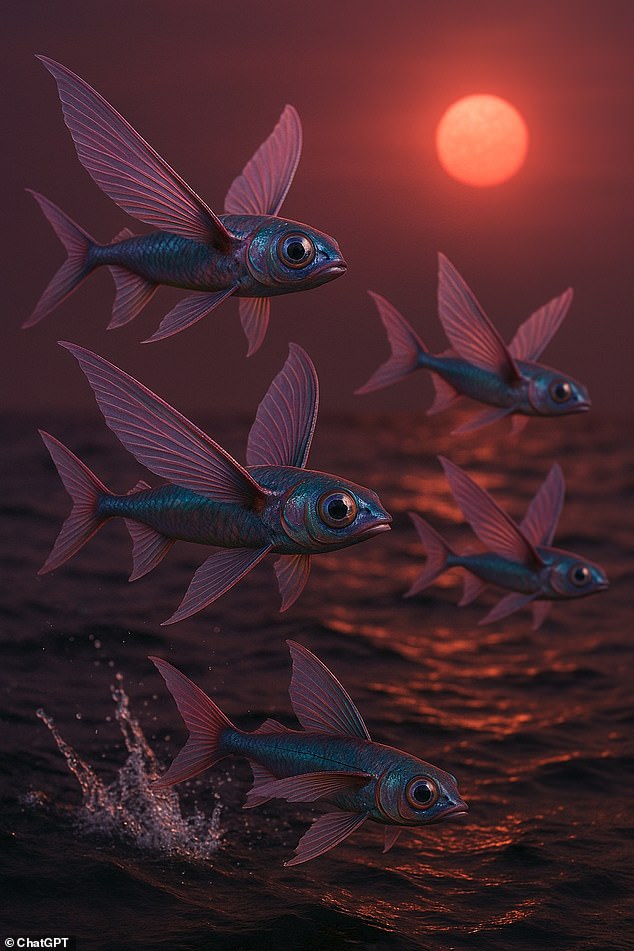
Scientists have said that flying fish or even birds might develop on water worlds to avoid predators (AI impression)

Since the light from the red dwarf star is so dim, any creatures in K2-18bs oceans would have evolved very large eyes (AI impression)
Since K2-18b orbits a red dwarf star, the light reaching the planet will be dim which places some constraints on how life could develop.
Astronomer Michael Garrett, a professor at Manchester University, previously told MailOnline: ‘I think the way complex life might appear will depend a lot on the environment within which it evolves.
‘If your star is a red giant, you might find life with eyes that are much more sensitive and larger than ours.’
Professor Garrett also said that if the world had a low-density atmosphere, it may have ‘life forms with wings of enormous scale’.
Likewise, in 2013, NASA researchers discovered two water worlds, called Kepler-62e and Kpler-62f, which were promising candidates in the search for life.
Speaking to Space.com at the time, lead researcher Bill Borucki, of NASA’s Ames Research Center, said that these planets could be home to fish or even birds.
Mr Borucki said: ‘At least in our ocean, we have flying fish. They ‘fly’ to get away from predators. So we might find that they have evolved — birds — on this ocean planet.’
Since K2-18b is a water world just like Kepler-62e and 62f, its oceans could also be home to strange alien flying fish or even sea birds.






